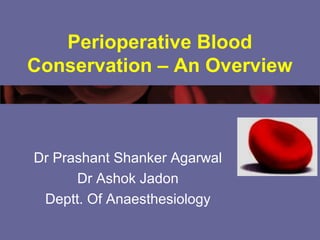The document provides an overview of blood conservation strategies in perioperative patients. It discusses why blood conservation is important to conserve limited blood resources and reduce risks of transfusion. Key strategies mentioned include preoperative patient optimization, use of antifibrinolytics like tranexamic acid, controlled hypotension, cell salvaging, normovolemic hemodilution, and autologous blood donation and transfusion to avoid allogeneic transfusions and their associated risks. The document emphasizes a multidisciplinary team approach and utilization of the latest drugs, techniques and technology to minimize blood loss and reduce need for allogeneic blood transfusions in surgical patients.







































